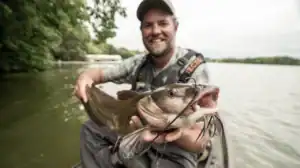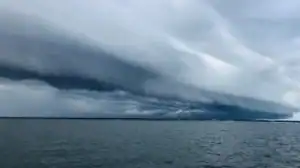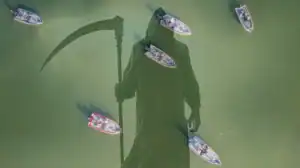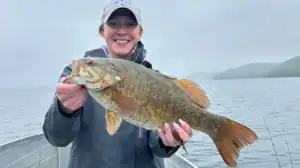In the fall of 2024, the professional bass-fishing powers that be made judgement calls on the use of forward facing sonar (FFS) in tournament events. Anglers competing at the top levels of the B.A.S.S., Major League Fishing (MLF), and National Professional Fishing League (NPFL) trails had new rules and regulations in place coming into the 2025 season. Presumably, the primary purpose of these rules, whether clearly stated or not, was to bring parity back to bass fishing. Virtually every $100,000 paycheck in the last three years has been won by an angler staring at a screen. And that had become a sore spot for many competitors and boring for a lot of the fans that watch these tournaments unfold.
Now, halfway through the 2025 pro bass season, have the new rules and scheduling adjustments made a difference? Let’s unpack what those new standards are for each trail, and then see if we can tell if these measures have helped bring some of the excitement back to bass fishing.
New FFS Rules And Regulations for 2025
The new B.A.S.S. rules regarding FFS for 2025 included limiting cumulative screen size on each boat to 55 inches, as well as prohibiting the use of more than one forward facing sonar transducer on each boat. B.A.S.S. also arranged their Elite Series schedule to create diversity along the circuit and give bank beaters and old school anglers a puncher’s chance.

MLF chose to limit each angler to two forward facing/360 transducers for the 2025 season. More importantly, MLF also elected to limit the amount of time per event that the technology could be used; anglers are only permitted to use FFS for one of three periods each day of a tournament event.
Whether intentional or not, the MLF Bass Pro Tour schedule was also weighted heavily to favor the shallow fisherman.
The NPFL went full-send and outright banned FFS technology for the 2025 season.
So, How’s It Going?
At the moment, the BP Tour, NPFL, and Elite Series trails are about half over and the spring spawn is behind us with the fish moving farther offshore by the minute. It stands to reason that the best shallow bite is behind us now, too. Therefore, we can only presume FFS will play an even bigger part in the remaining events with fish staging deeper or suspending. But that part is still to be determined; here’s what we know so far:
NPFL
Naturally, with FFS banned in the NPFL, all three of the events that have been completed were won with “just fishing.” Greg Hackney won the first event on Lake Norman by sight fishing and blind fishing for bedding fish, Jason Christie won stop number two on Santee Cooper slow rolling a spinnerbait around cypress trees, and Scott Canterbury just won the third NPFL event of the season on Lake Douglas by bouncing back and forth between an early shallow bite and a deeper brush later in the day.

MLF Bass Pro Tour
On the MLF Bass Pro Tour side of things, Justin Cooper won Stage 1 on Lake Conroe, Bobby Lane won Stage 2 on the Harris Chain, Drew Gill won Stage 3 at Lake Murray, and Jake Lawrence took home the win at Stage 4 on Chickamauga and Nickajack.
Cooper took advantage of the tech during the first period of each day at Lake Conroe, marking areas with fish and cover and then returning to them later in the day to blind-cast vibrating jigs and lipless crank around hydrilla.
Gill also mixed things up, doing the jighead minnow deal early on Murray using FFS and then shifting to a neko rig around docks later in the day.
Lawrence won on Chickamauga in dramatic fashion, boating a 5-pound, 9-ounce kicker on a buzzbait with just 21 seconds left in tournament to edge out perennial powerhouse Jacob Wheeler, who arguably relied more on FFS for his deep bite than Lawrence did for his bluegill bed bite.
At Harris Chain, Floridian Lane elected not to use FFS throughout the entire event, even though he was allowed to for one of three periods each day. MLF actually has a column on their daily results page where you can see which period the anglers chose to use FFS.
Interestingly, several other anglers have opted out of the FFS game along the BPT trail this year, even though their competition is allowed to and choosing to use it.
There were six of the top 10 at Harris Chain that never turned their FFS on throughout the whole competition.

B.A.S.S. Elite Series
In the Bassmaster Elite Series, Bill Lowen came charging out of the gate for the shallow-water fishing fans and flipped and swam a jig to victory on the St. Johns River. Brandon Palaniuk won the second stop on Lake Okeechobee using a jerkbait, crankbait, glidebait, punching rig, and Neko rig, as well as Humminbird’s MEGA Live 2 (FFS) and MEGA 360 Imaging.
Kyle Welcher blew the doors off the competition on stop three at the Pasquotank River in North Carolina, winning by 45 pounds, 7 ounces, the largest margin of victor in Elite Series History. Welcher relied heavily on FFS to target pre-spawn and spawning bass around cypress stumps and knees.
Paul Marks got his first win on Lake Hartwell using FFS a good bit around herring spawns and deeper cover. Tucker Smith took home the win and his first century belt on Lake Fork with 127 pounds, 8 ounces in four days and 20 fish. Smith relied heavily on FFS, catching his fish on a jighead minnow and a jig.
Lastly, Pat Schlapper just went wire-to-wire to win on the Sabine River flipping and fishing a buzzbait.
How It All Shook Out

From 30,000 feet, I’d chalk four of the six wins on the Elite tour up to FFS. The MLF Bass Pro Tour had a good 40/60 mix when weighing the importance of FFS to each champion’s victory, with Bobby Lane’s Harris Chain win tipping the scales away from FFS being the dominant and determining factor more often than not. Obviously, nobody used FFS to grab a win on the NPFL tour.
If parity and not pure hatred of FFS was the motivation for the new 2025 rules, then I think we can call the spring a success across the whole sport. The NPFL has given the nostalgic angling enthusiast a reprieve, as we’ve seen some of our heroes go out there and grind up wins with old-school fishing. MLF dialing back the use of FFS to 33% of the competition time has certainly limited its dominance, and we’ve even seen a champion in Bobby Lane win one of their events without ever even turning it on.
And on the B.A.S.S. side, the scheduling seems to be making things more interesting too. When it comes to scheduling, both timing and location play a large part into how the lakes and rivers will fish and if FFS will dominate. Scheduling deserves some credit for both Lowen’s win and Pat Schlapper’s win. B.A.S.S. hit the nail on the head for Lowen to be able to win on a jig at the St John’s, where John Crew’s won in 2022 using FFS heavily. And the shallow and grimy Sabine River offers very little water that’s conducive to typical FFS tactics, allowing Schlapper the opportunity to fish a buzzbait and flip a jig to a win there.
Even in the events where the win could either be credited in part or nearly entirely to FFS, we still saw a greater variety of baits used this spring thanks to the new rules and scheduling. On the MLF Bass Pro Tour, we saw FFS used to locate structure, cover, and fish during certain periods. But then anglers like Justin Cooper still had to mix in traditional fishing techniques and tactics in the other periods, while blind fishing those same areas.

Don’t forget, what could be construed as a silent protest from some of the veterans of the sport on the MLF tour are making, opting to not use FFS at all in certain events. It paid off for Bobby Lane on the Harris Chain, another scheduling win for the folks that aren’t fans of FFS.
When FFS did play a big role in a win, at least it wasn’t just paired with a jighead minnow and a spinning rod. Palaniuk had some wild catches on a glidebait using FFS at Okeechobee. Welcher showed us too that an angler can still separate himself from the pack massively, proving that FFS isn’t some magic bullet equalizer; It also made things more interesting that Welcher absolutely jacked giants with a baitcaster in that event.
Final Thoughts
If you hate FFS and want it banned outright across all of bass fishing, I believe you’re in for a rough future. You can’t put the genie back in the bottle now, and there’s too much money involved. That’s not a shot at the electronics companies or some allusion to a conspiracy, it’s a simple statement of fact.
FFS has shifted the entire industry; from lure manufactures to rod and reel builders to fishing line companies, everyone has had to adjust. It’s taken years for some to do an about-face. The process has severely impacted the bottom line of many companies, and another redirect could bankrupt several more than the previous shift already has. Bottom line: doing away with FFS isn’t a reality, unless the government gets involved, and I think most of us can agree, that isn’t a desired solution.
I believe we’ll see the sport continue to evolve around this subject a bit. But I think we’ll pretty much have what we have for a while. NPFL won’t go back, their no-FFS competition is drawing the eyes of fans and the participation of top competitors and legends of the sport. They have found their niche.
With MLF already limiting FFS to one of three periods, they can’t go much further than that, other than to ban it outright or ban it for a specific day of competition. I don’t think either of those ideas benefit their anglers, fans or bottomline much. Though I would love to see a standalone event by MLF each year that doesn’t allow FFS, and I could see them doing something like that.
B.A.S.S. appears to have dug in; after allowing the whole thing to play out in real time for several seasons, it became evident that something had to be done. In 2024, some anglers reportedly had as many as a half dozen FFS transducers mounted on everything from their trolling motors to their shallow water anchors. And they were often paired with graphs the size of TV screens. Something had to be done indeed, and limitations were set (as much for safety as anything). We now have what we’ll have on the Elite Series for the foreseeable future, I believe.
Love it or hate it, it appears the new rules and regulations are working pretty well across the whole sport. At the season’s halfway mark, at least half of the completed events have been won without FFS being the primary difference maker. As a fan who just wants to enjoy the sport, I’m liking this season better than the last few.










